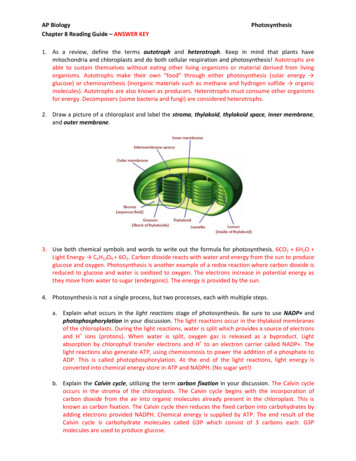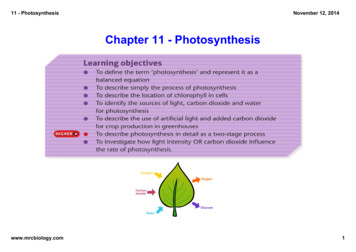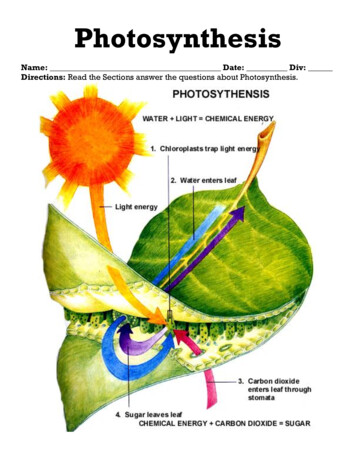
Transcription
AP BiologyChapter 8 Reading Guide – ANSWER KEYPhotosynthesis1. As a review, define the terms autotroph and heterotroph. Keep in mind that plants havemitochondria and chloroplasts and do both cellular respiration and photosynthesis! Autotrophs areable to sustain themselves without eating other living organisms or material derived from livingorganisms. Autotrophs make their own “food” through either photosynthesis (solar energy glucose) or chemosynthesis (inorganic materials such as methane and hydrogen sulfide organicmolecules). Autotrophs are also known as producers. Heterotrophs must consume other organismsfor energy. Decomposers (some bacteria and fungi) are considered heterotrophs.2. Draw a picture of a chloroplast and label the stroma, thylakoid, thylakoid space, inner membrane,and outer membrane.3. Use both chemical symbols and words to write out the formula for photosynthesis. 6CO2 6H2O Light Energy C6H12O6 6O2. Carbon dioxide reacts with water and energy from the sun to produceglucose and oxygen. Photosynthesis is another example of a redox reaction where carbon dioxide isreduced to glucose and water is oxidized to oxygen. The electrons increase in potential energy asthey move from water to sugar (endergonic). The energy is provided by the sun.4. Photosynthesis is not a single process, but two processes, each with multiple steps.a. Explain what occurs in the light reactions stage of photosynthesis. Be sure to use NADP andphotophosphorylation in your discussion. The light reactions occur in the thylakoid membranesof the chloroplasts. During the light reactions, water is split which provides a source of electronsand H ions (protons). When water is split, oxygen gas is released as a byproduct. Lightabsorption by chlorophyll transfer electrons and H to an electron carrier called NADP . Thelight reactions also generate ATP, using chemiosmosis to power the addition of a phosphate toADP. This is called photophosphorylation. At the end of the light reactions, light energy isconverted into chemical energy store in ATP and NADPH. (No sugar yet!)b. Explain the Calvin cycle, utilizing the term carbon fixation in your discussion. The Calvin cycleoccurs in the stroma of the chloroplasts. The Calvin cycle begins with the incorporation ofcarbon dioxide from the air into organic molecules already present in the chloroplast. This isknown as carbon fixation. The Calvin cycle then reduces the fixed carbon into carbohydrates byadding electrons provided NADPH. Chemical energy is supplied by ATP. The end result of theCalvin cycle is carbohydrate molecules called G3P which consist of 3 carbons each. G3Pmolecules are used to produce glucose.
5. The details of photosynthesis will be easier to organize if you can visualize the overall process. Labeldiagram below. As you work on this, underline the items that are cycled between the light reactionsand the Calvin cycle.6. Some of the types of energy in the electromagnetic spectrum will be familiar, such as X-rays,microwaves, and radio waves. The most important part of the spectrum in photosynthesis is visiblelight. What are the colors of the visible spectrum? The visible spectrum ranges from 380 nm to 750nm with colors ranging from violet, indigo, blue, green, yellow, orange and red.7. Explain the relationship between wavelength and energy. The shorter the wavelength of light, thehigher the energy. The longer the wavelength of light, the lower the energy. Therefore, red light hasless energy than violet light because it has a longer wavelength.8. What colors of the visible spectrum are used for photosynthesis? Pigments are light absorbingprotein molecules. The primary pigments in chloroplasts are chlorophyll a and chlorophyll b andaccessory pigments called carotenoids. Chlorophyll a absorbs violet-blue and red light best. Greenlight is the least effective light for photosynthesis.9. What is a photosystem? A photosystem is an organized association of proteins holding a pair ofchlorophyll a molecules surrounded by various other pigment molecules (cholorophyll a, b andcarotenoids) bound to proteins. It acts as a reaction center and a light harvesting complex.10. Within the photosystems, the critical conversion of solar energy to chemical energy occurs. Thisprocess is the essence of being a producer! Label the diagram and then explain the role of the termsin the photosystem.Reaction center complex – an excited electron from thespecial pair of chlorophyll molecules is transferred to aprimary electron acceptorLight-harvesting complex – a pigment molecule absorbs aPhoton from light energy and passes the energy frompigment molecule to pigment molecule until it reachesthe reaction center complexPrimary electron acceptor – accepts electrons andbecomes reduced, prevents the potential energy frombeing lost as light and heat
11. Linear electron flow is, fortunately, easier than it looks. While reading the section “Linear ElectronFlow,” label the diagram number by number as you read.12. The following set of questions deal with linear electron flow:a. What is the source of energy that requires the electron in photosystem II? Chlorophyll pigmentsb. What compound is the source of electrons for linear electron flow? Water This compound is alsothe source of oxygen in the atmosphere.c. As electrons fall between photosystem II and II, the cytochrome complex uses the energy topump hydrogen ions. This builds a proton gradient that is used in chemiosmosis to producewhat? ATPd.In photosystem II, the excited electron is eventually used by NADP reductase to join NADP and a H to form NADPH.* Note that two high-energy compounds have been produced by the light reactions: ATP andNADPH. Both of these compounds will be used in the Calvin cycle.13. Label all the locations in the diagram first. Next, follow the steps in linear electron flow to label thecomponents of the light reactions in chemiosmosis.
14. As a review, note that the light reactions store chemical energy in ATP and NADPH, which shuttlethe energy to the carbohydrate-producing Calvin cycle.The Calvin cycle is a metabolic pathway in which each step is governed by an enzyme. However, keepin mind that the Calvin cycle uses energy (in the form of ATP and NADPH) and is therefore anabolic; incontrast, cellular respiration is catabolic and releases energy that is used to generate ATP and NADH.15. The carbohydrate produced directly from the Calvin cycle is not glucose, but the three-carboncompound G3P. Each turn of the Calvin cycle fixes one molecule of CO2; therefore, it will take threeturns of the Calvin cycle to net one G3P.16. Explain the important events that occur in the carbon fixation stage of the Calvin cycle. Each carbondioxide molecule is joined to a 5-carbon molecule called RuBP with the assistance of an enzymecalled Rubisco. The resulting 6-carbon molecule immediately splits into two 3-carbon molecules.17. The enzyme responsible for carbon fixation in the Calvin cycle, and possibly the most abundantprotein on Earth, is Rubisco (ribulose bisphosphate carboxylase).18. In phase two, the reduction stage, the reducing power of NADPH will donate electrons to the lowenergy acid 1,3-bisphosphoglycerate to form the three-carbon sugar G3P.19. Examine Figure 8.17 in your textbook while we tally carbons. This figure is designed to show theproduction of one net G3P. That means the Calvin cycle must be turned three times. Each turn willrequire a starting molecule of ribulose bisphosphate (RuBP), a five-carbon compound. This meanswe start with 15 carbons distributed in three RuBPs. After fixing three carbon dioxides using theenzyme Rubisco, the Calvin cycle forms six G3Ps with a total of 18 carbons. At this point the net gainof carbons is 3, or one net G3P molecule.20. Three turns of the Calvin cycle nets one G3P because the other five must be recycled to RuBP.Explain how the regeneration of RuBP is accomplished. The carbon skeletons of 5 molecules of G3Pare rearranged into 3 molecules of RuBP. This reconfiguration requires the energy of 3 ATPmolecules.21. The net production of one G3P requires 9 molecules of ATP and 6 molecules of NADPH.
22. Now that you have worked through the entire chapter, study Figure 8.19. Use the T chart below tocompare the light reactions and the Calvin cycle reactions of photosynthesis. If you can do this, youunderstand the “big picture”.
AP Biology Photosynthesis Chapter 8 Reading Guide – ANSWER KEY 1. As a review, define the terms autotroph and heterotroph.Keep in mind that plants have mitochondria and chloropl










